Experimenting with the Laws of Motion  This week in class we investigated the physics of motion by recreating a simplified version of a very famous invention - Hero of Alexandria's aeolipile, or "steam ball". As students have read in our text, Hero was a designer of many ingenious and whimsical inventions. The aeolipile is perhaps his most notable work because it is considered to be the first recorded steam engine or reaction steam turbine - developed many thousands of years before the Industrial Revolution. The sphere had bent nozzles projecting from its sides, angled up and down (for opposing forces). When heated from below, steam would shoot out through the nozzles resulting in thrust that would then cause the sphere to spin. Before beginning our experimentation, we took some time to review Newton's 3 Laws of Motion. Of course, Newton would not develop his Universal Law of Gravitation or these Laws of Motion until the 17th century. However, Hero's work clearly demonstrated these laws many hundreds of years earlier. Pop Can Hero! 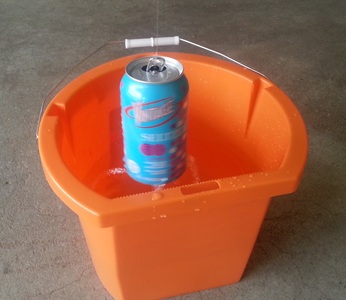 Students simulated the operation of a classic aeolipile by constructing water-propelled engines out of soft drink cans. Specifically, they investigated ways to increase the action-reaction thrust produced by water shooting out of holes punched in the sides of the can. After an initial demonstration of how to generate spin by punching angled holes in the can with nails (Newtons 3rd Law of motion), the class spent some time speculating on what variables might increase the number of pop can rotations. The class came up with three variables to test: 1) number of holes, 2) size of holes and 3) placement of holes. They then split into three teams, with each team assigned one variable to test. Teams developed their hypothesis and their testing procedures using the experiment worksheet, and then began building their engines (each team built three engines to test various designs). We discussed the importance of creating a baseline and then changing only one variable at a time. Interestingly, all three teams formulated correct hypotheses: 1) that fewer holes would result in more rotations because the water pressure would remain higher for longer, allowing the water to drain out more slowly, 2) that smaller sized holes would also result in a greater pressure and therefore a greater number of rotations, and 3) that placement of holes at the base of the can (versus higher up) would result in a greater number of rotations. Although the team results did point toward verified hypotheses, the results of all teams were not conclusive. One additional factor that students discovered was the importance of keeping the length of the string (we used fishing line) constant for each engine tested. A twisting force added by a longer or shorter string can modify the number of can rotations. Also, several teams were able to get very high accelerations of spin, which made it difficult to accurately count the number of rotations. While students found it somewhat unsatisfying to have inconclusive results, this opened up the opportunity to discuss possible modifications to our experimental design, and the need for further testing - all important aspects of real world scientific investigation! Catapults and Homework 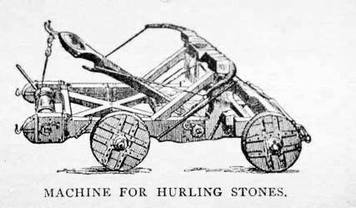 Continuing our study of the physics of machines, students were given supplies and instructions for building and testing a simple catapult at home. I have encouraged them to include siblings and family members in this project - it's fun and really lends itself to multi-age learning. Please make sure to complete the catapult homework sheet and bring it back to class next week with your catapult. Students should also read Chapter 17 on Archimedes in preparation for next weeks class discussion and projects.  Reader's Theatre class started this week with a dialogue on the characters of William Shakespeare's play "Hamlet." A handout was given to the students on all the characters that are in the reader's theatre version we are studying. This character analysis not only offered them a chance to better understand the actions of the play, but is also preparing them to dive deeper into a character of their choice for the next two weeks' homework assignment. To Be or Not to Be...(that is, in fact, the question)
Science History Jeopardy!  Our class engaged in a Jeopardy trivia game this week, covering material from Chapters 1-13 in the text. We are at the midway point in our semester and the format provided a fun, competitive 'refresher' of information we've discussed and read about over the past eight weeks. Students were randomly assigned to three teams of three, and then teams took turns answering challenging questions. If a team failed to provide a correct answer, the following team had the option of stealing that question. We finished with our teams fairly evenly matched for points (11, 12, and 7), and with the possibility for any team to win - if they wagered enough points and answered the Final Jeopardy Question correctly. I have provided the entire list of questions and answers (HERE) for students who were absent and for those who would like to review. Not all questions were asked, so have a look and see if you can answer all of them! 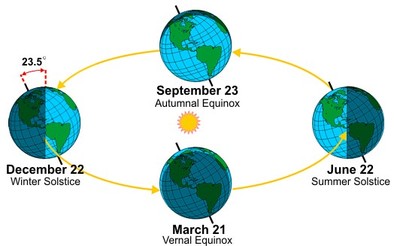 The final Jeopardy question required teams to provide a clear and accurate explanation of why Earth has seasons. Teams were also encouraged to draw a diagram to illustrate their explanation. Two of the three teams provided the correct answer - it is the tilt of Earth's axis at a 23.5 degree angle, that causes the seasons of our year. Congratulations to TEAM 2, with a wager of 11 points and the correct answer, making them the Jeopardy Champs with a total of 23 points! Ah Yes...Homework. And, what with the excitement of tallying the final scores, it seems I neglected to mention the homework for this week! Students should read Chapters 15 and 16 and complete the Student Quest Guide pages 55-56.
Next week we will talk about the intellectual city of Alexandria and the numerous inventions of Hero. Additionally, students should view the NOVA special airing this week called 'Ancient Computer'. It looks at some amazing ancient Greek technology and fits nicely with our class content. Trip to Europe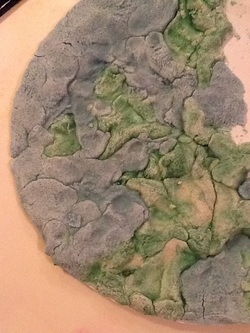 We concluded our study of Europe today with a Norse myth about Thor's hammer, The Dragon of Krakow (a Polish folktale), and a Swedish story about trolls. While we listened to the stories, we worked on salt dough maps of Europe. Can you tell which European countries your child made? I hope that the stories and the artwork will leave a strong impression on the children so that they will remember them in years to come as they learn more about geography and history. Ask your child if they can tell you one of the stories. We talked today about preparing our class presentations, and many of them are excited to tell the class a folktale. If they enjoyed this week's stories, then perhaps they will tell us another story from this part of the world! Atlas WorkAlso in class, the students practiced using atlases to do research. Each student had to find the answer to several questions. After discovering the answers, we shared them with the class. Do they remember their questions? Perhaps they can teach you something new about Europe. Do you know where Lapland is? What country is on the Jutland Peninsula? In what country will you find Transylvania?
Next week we move to Asia, learning about the geography and stories of China.
The homework assignment this week is to read through the script three times: 1. The first read through should be done silently as students highlight their part(s) and read the "acting notes" to better understand what they are saying. They should also reference their "Shakespeare terms" handout with definitions to some of the text that is not common, for instance, "anon" means "right now" OR "I come right away." 2. The second read through should be read aloud so they can play with the text rolling off their tongue and work on diction and inflections. Be creative and really try to get your meaning across. 3. The third time's a charm! This, too, should be read aloud (perhaps to a family member or maybe even your pet!) this time with more character in your voice and with lots of expression vocally and physically. Have fun with it! Next week we will look into our characters more and get to know them a little better. Have a great week! Greetings From Texas!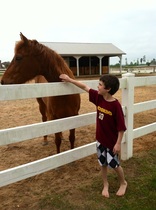 Aidan and Piper Aidan and Piper Half of the Harris Family arrived safely outside of Houston, Texas, on Easter Sunday; the other half is crossing the Louisiana swamps as we speak, stopping at various Visitors Centers in the area and trying to understand what the people are saying. They are also having some interesting culinary experiences (see: boudin). We thought of everyone yesterday and are busily trying to adjust to our new way of life. At left, Aidan enjoys one of our extended family's three horses (named Piper, Renegade, and Trinity). We look forward to seeing and visiting you each week via Mosaic Minutes and hold all of you in our hearts and thoughts. Until next week! |
Categories
All
Archives
May 2016
|

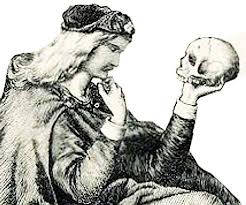

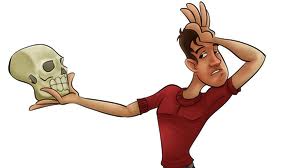
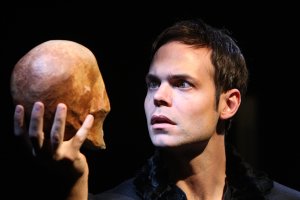

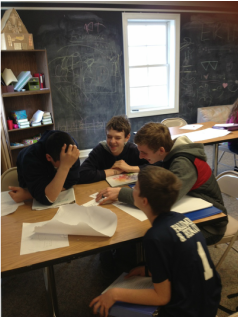
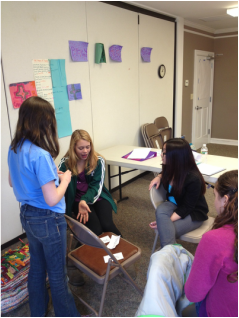
 RSS Feed
RSS Feed